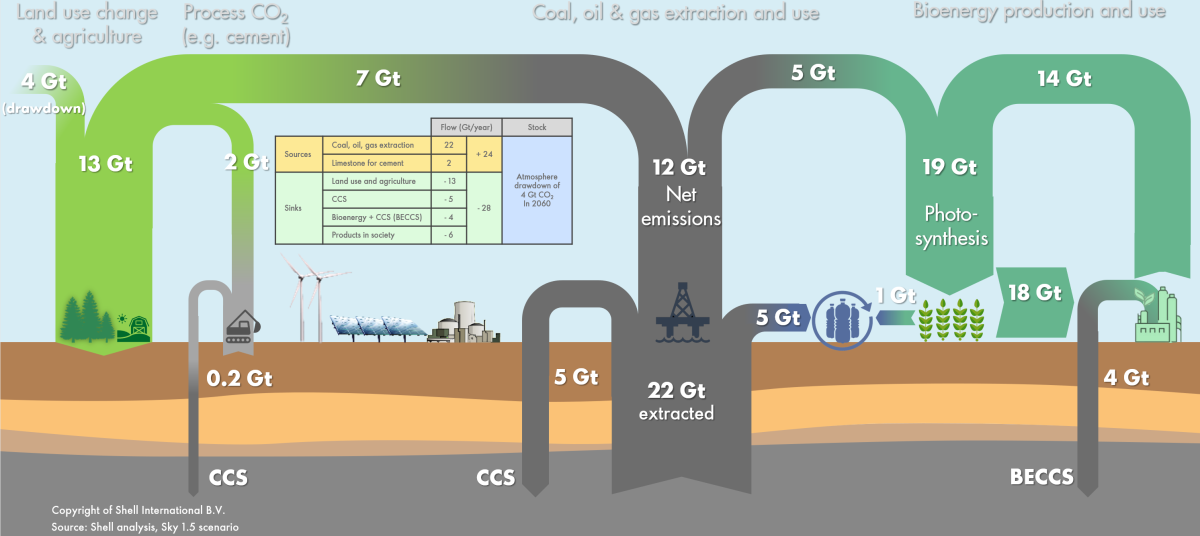
In 2018 when the IPCC released their Special Report on 1.5°C, they presented four archetype scenarios to help readers understand that there were fundamentally different approaches to limit long term warming to 1.5°C or below. The scenario pathways are shown below and vary significantly in their approach, time horizon and use of sinks.

All four scenarios (P1, P2, P3, P4) are based around the same carbon budget, or total cumulative emissions of 420 Gt from 1.1.2018 consistent with providing a 66% chance of limiting warming to 1.5°C. Whether the carbon budget is aligned with 420 Gt (67th percentile) or 580 Gt (50th percentile), it represents a very limited amount given that annual CO2 emissions are in excess of 40 Gt, so these represent 10-15 years of emissions at current levels. Since this IPCC publication, a further 160 Gt will have been emitted by society by the end of 2021, meaning that the budget is reduced to 260 – 420 Gt.

In attempting to align with a very limited carbon budget, the P1 scenario imagines a world of falling overall energy use and a very rapid shift away from fossil fuels. There is no use of geological storage of CO2 and a modest reliance on natural sinks, although in doing so the world must shift away from net-deforestation by the 2040s. By contrast, the P4 scenario sees increasing demand for energy and as a consequence, a much more difficult decarbonisation journey that involves considerable use of sinks in the second half of the century. Notably, the P4 scenario exceeds the carbon budget by quite some amount with peak emissions to the atmosphere of 900 Gt, before reining in the amount to 200 Gt by 2100. This results in P4 being a so-called overshoot scenario, in that the world exceeds 1.5°C during the century before returning to 1.5°C and below by the end of the century.

All the above might seem a bit academic, but it became very real recently when the IEA released their 1.5°C scenario and some commentators began comparing it to one of the very few other 1.5°C scenarios, notably Sky 1.5 from Shell.
In fact, the two scenarios are at near opposite ends of the P1 to P4 spectrum.
The IEA 1.5°C scenario looks at the period from 2020 to 2050 and presents a proposal for the problem of containing emissions to a 500 Gt carbon budget (the 580 Gt IPCC number less 80 Gt for the years 2018 and 2019). Apart from recognising that the land based system is likely to reduce this budget by a further 40 Gt over the period (i.e. reducing it to 460 Gt), the analysis limits itself to the energy system and the changes that would be required to meet a 460 Gt cumulative emissions constraint within a 30 year time frame. As is the case in similar scenarios, including Sky 1.5, their analysis assumes rapid electrification of final energy (e.g. electric cars instead of gasoline) and makes use of renewables and nuclear power generation to produce the electricity. They introduce hydrogen as an energy carrier, make use of bioenergy and include carbon capture and storage (CCS) where fossil fuel remains in use. For the latter, the IEA deploy CCS directly on facilities that use fossil fuels and indirectly through direct air capture for fossil fuel use in applications such as aviation.
All the above steps are well understood, but even given rapid and stretching deployment rates of all technologies, these steps are unlikely to contain emissions to less than 500 Gt in under thirty years. This is because of the expected increase in overall energy use, a consequence of economic growth, the general rise in population and the shift of billions of people from very low energy use lifestyles to at least modest energy use, a simple outcome of development and the provision of basic services like lighting, clean water, food refrigeration and some mobility.
As such, energy modelers looking at a very constrained time frame of 30 years must make the assumption that energy growth can be contained or even fall, as in the IPCC P1 scenario. This is exactly what the IEA have done to meet the carbon constraint. In the 1.5°C Scenario primary energy demand falls from 612 EJ in 2019 to 543 EJ in 2050, a drop of over 10%. Efficiency will certainly help deliver such an outcome and the use of renewable electricity gives the story a big boost as the thermal losses in power stations vanish, although new losses emerge through the use of transmission and storage. But the big story is the widespread assumption of behavioural change across society to reduce energy demand. The chosen measures include steps such as;
- Ride-sharing in all urban car trips
- Reducing motorway / freeway speeds to below 100 kph / 60 mph.
- Increasing temperatures in air conditioned vehicles and buildings.
- Lowering temperatures in heated buildings.
- Replacing short flights with high speed rail.
- Limiting long haul air travel to 2019 levels.
With low energy demand and high deployment rates of new energy technologies it then becomes possible to resolve the carbon budget within a 30 year time frame.
At the other end of the spectrum is the Sky 1.5 scenario, which tackles the problem of a limited carbon budget in a very different way. Sky 1.5 looks at the period from 2020 to 2100, an 80 year time frame, and starts with an expectation of rising global energy demand, even assuming significant energy efficiency improvements across society. The growth in population and the demand for energy services, including significant new demand from developing countries for basic services, cannot be contained and energy demand rises. This immediately poses a challenge in that rising demand more quickly consumes the available carbon budget at the front end, when alternative energy technologies and sinks have not been deployed.
Sky 1.5 also recognises that for many energy technologies, the 2020s still remain a period of development and limited deployment and even for more mature technologies such as solar and wind, a period of early growth where change on a global scale will remain limited.
The solution to this approach is to accept that, at least in the short term, the carbon budget may be consumed and the temperature it is linked to (1.5°C in this case) potentially surpassed for a period of time. The subsequent rapid deployment of sink capacity, both manmade in the form of air capture and natural as reforestation, then offers the possibility of a period of net-negative emissions later in the century, to redress the imbalance and reduce cumulative carbon dioxide emissions and therefore temperature. This is the approach that Sky 1.5 takes, as do the IPCC P3 and P4 scenarios. Sky 1.5 takes this approach out of necessity, in that the scenario reaches a limit on energy technology deployment and does not foresee a fall in energy demand.
The end carbon budget for both the IEA 1.5°C scenario and Sky 1.5 are similar, but the IEA restricts itself to a thirty year time-frame, whereas Sky 1.5 operates over an eighty year time-frame. Sky 1.5 is also remodeled by MIT within their integrated assessment model to give a temperature outcome, rather than simply using the IPCC central estimate for a carbon budget. The two scenarios are attempting to answer the same question, but take very different approaches to doing so. There is no right or wrong here, just different ways of solving a tough problem.
Note: Scenarios don’t describe what will happen, or what should happen, rather they explore what could happen. Scenarios are not predictions, strategies or business plans. Please read the full Disclaimer here.

Average Rating